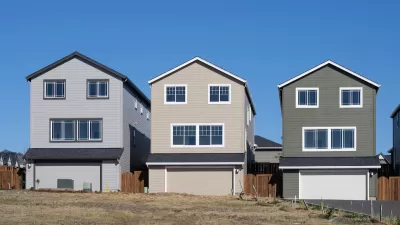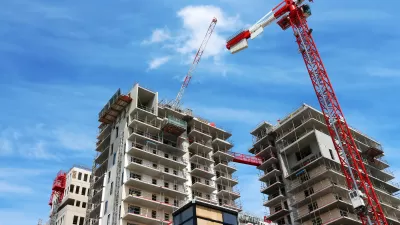Recent analysis shows that Americans are less willing to pay extra for large houses. It's information best viewed skeptically, but it's also worth considering why this trend has finally, semmingly swung the other way.

Joe Cortright continues an ongoing crusade to elucidate the facts about the creation and consumption of McMansions in the housing market.
Cortright's commentary follows a round of "downbeat" stories about the demand for McMansions. Stories from Bloomberg and the Chicago Tribune followed the lead of Trulia's Ralph McLaughlin, who compared price trajectories of 3,000- to 5,000-square-foot homes built between 2001 and 2007 with all other homes in each metropolitan area. "McLaughlin found that since 2012, the premium that buyers paid for these big houses fell pretty sharply in most major metropolitan markets around the country," explains Cortright. "Overall, the big house premium fell from about 137 percent in 2012 to 118 percent this year."
According to Cortright, the falling premiums for McMansions might have to do with the aging process: "Like new cars, McMansions may have their highest value when they leave the showroom…" But according to Cortright, another factor could also be working against the McMansion: as demand for urban, walkable areas has increased, demand for McMansions built on the periphery of metropolitan areas has not gone unscathed.
Finally, says Cortright, the market factors that drove the boom in McMansions in the bubble years just no longer exist.
The bad news for the McMansion market is new—Planetizen was picking up stories that reported of a renewed trend toward houses of larger and larger sizes around the United States as recently as July of 2016 (and also in June 2014). Cortright, however, offered a dissenting opinion about how the real estate's data skewed toward a false portrayal of McMansion dominance in the market.
FULL STORY: McMansions Fading Away?

Maui's Vacation Rental Debate Turns Ugly
Verbal attacks, misinformation campaigns and fistfights plague a high-stakes debate to convert thousands of vacation rentals into long-term housing.

Planetizen Federal Action Tracker
A weekly monitor of how Trump’s orders and actions are impacting planners and planning in America.

San Francisco Suspends Traffic Calming Amidst Record Deaths
Citing “a challenging fiscal landscape,” the city will cease the program on the heels of 42 traffic deaths, including 24 pedestrians.

Defunct Pittsburgh Power Plant to Become Residential Tower
A decommissioned steam heat plant will be redeveloped into almost 100 affordable housing units.

Trump Prompts Restructuring of Transportation Research Board in “Unprecedented Overreach”
The TRB has eliminated more than half of its committees including those focused on climate, equity, and cities.

Amtrak Rolls Out New Orleans to Alabama “Mardi Gras” Train
The new service will operate morning and evening departures between Mobile and New Orleans.
Urban Design for Planners 1: Software Tools
This six-course series explores essential urban design concepts using open source software and equips planners with the tools they need to participate fully in the urban design process.
Planning for Universal Design
Learn the tools for implementing Universal Design in planning regulations.
Heyer Gruel & Associates PA
JM Goldson LLC
Custer County Colorado
City of Camden Redevelopment Agency
City of Astoria
Transportation Research & Education Center (TREC) at Portland State University
Jefferson Parish Government
Camden Redevelopment Agency
City of Claremont





























